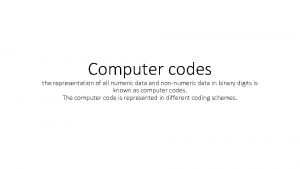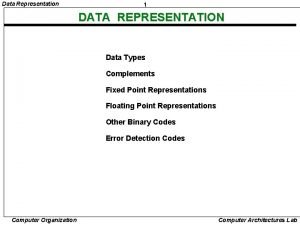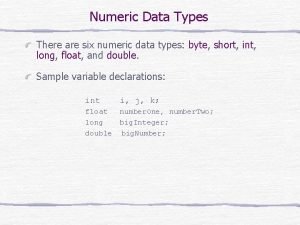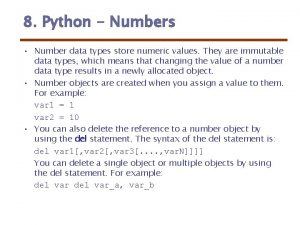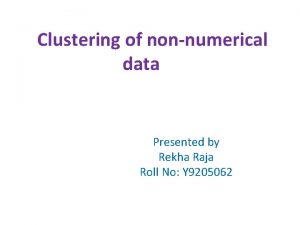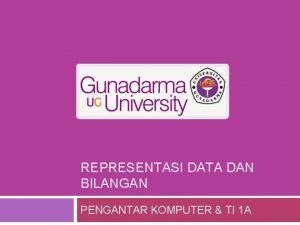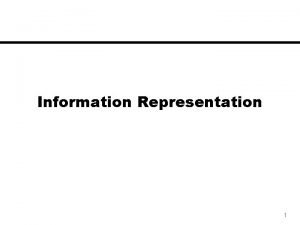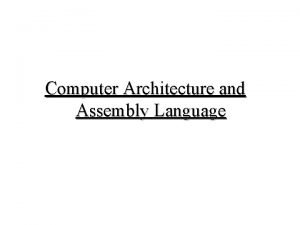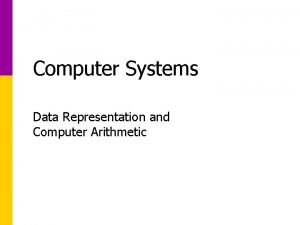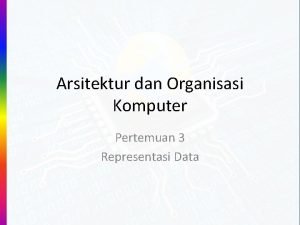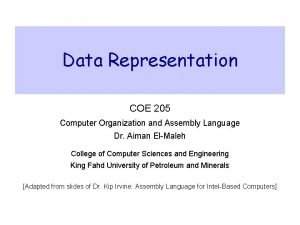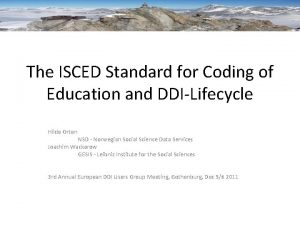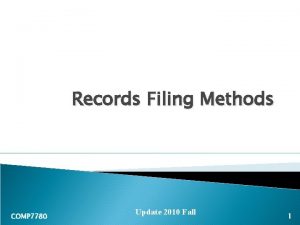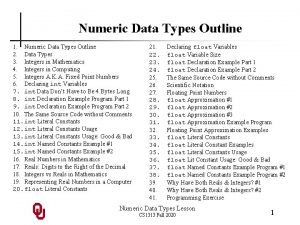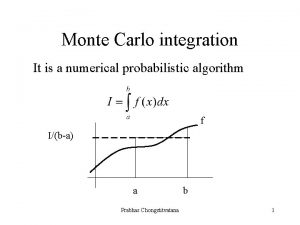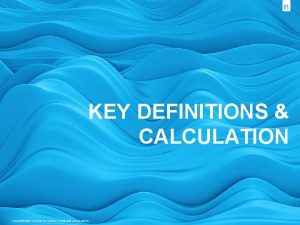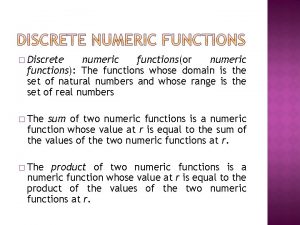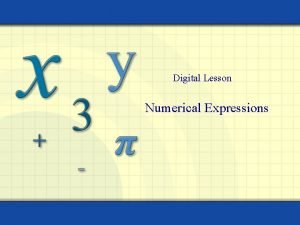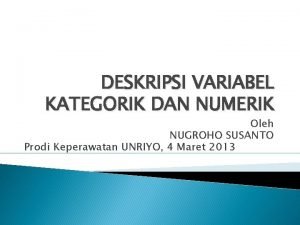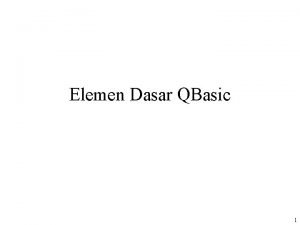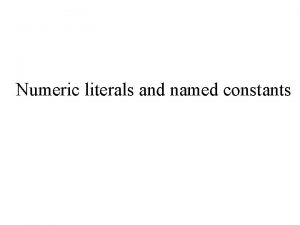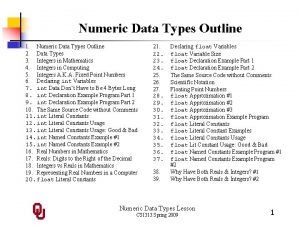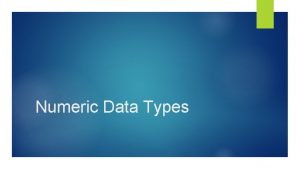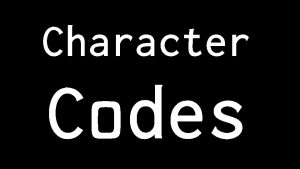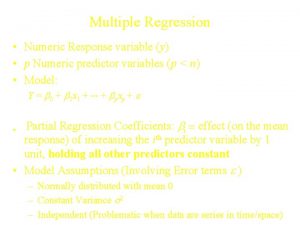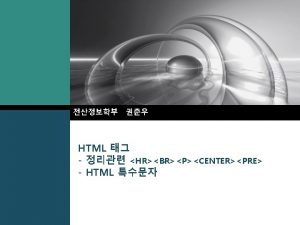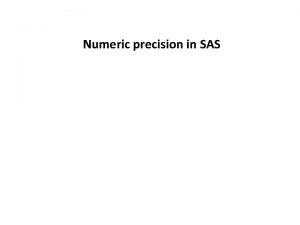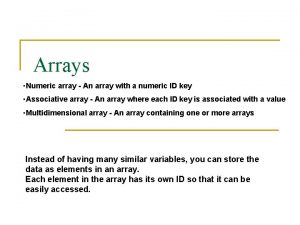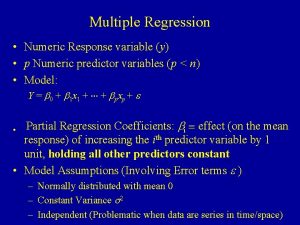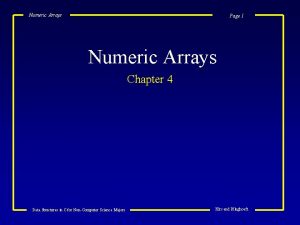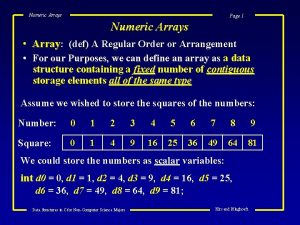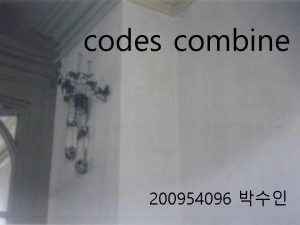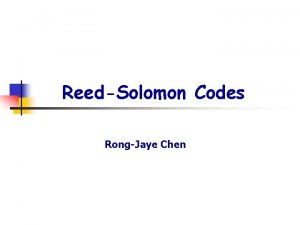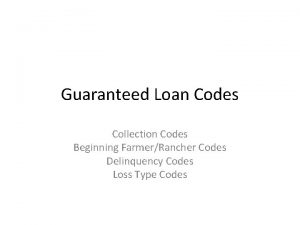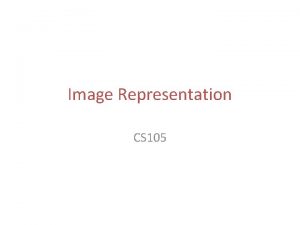Computer codes the representation of all numeric data























- Slides: 23

Computer codes the representation of all numeric data and non-numeric data in binary digits is known as computer codes. The computer code is represented in different coding schemes.

DIGITAL CODES • In practice the digital electronics requires to handle data which may be numeric, alphabets and special characters. This requires the conversion of the incoming data into binary format before it can be processed. There is various possible ways of doing this and this process is called encoding. To achieve the reverse of it, we use decoders.

Encoding: is the process of putting a sequence of characters (letters, numbers, punctuation, and certain symbols) into a specialized format for efficient transmission or storage. Decoding: is the opposite process -- the conversion of an encoded format back into the original sequence of characters.

• WEIGHTED AND NON-WEIGHTED CODES: - There are two types of binary codes • 1) Weighted binary codes • 2) Non- weighted binary codes • In weighted codes, for each position ( or bit) , there is specific weight attached. For example, in binary number, each bit is assigned particular weight 2 n where ‘n’ is the bit number for n = 0, 1, 2, 3, 4 the weights are 1, 2, 4, 8, 16 respectively. Example : - BCD • Non-weighted codes are codes which are not assigned with any weight to each digit position, i. e. , each digit position within the number is not assigned fixed value. Example: - Excess – 3 (XS -3) code and Gray codes.

BINARY CODE • The binary number system has many advantages and is widely used in digital systems. However, there are times when binary numbers are not appropriate. Since we think much more readily in terms of decimal numbers than binary numbers, facilities are usually provided so that data can be entered into the system in decimal form, the conversion to binary being performed automatically inside the system. In fact, many computers have been designed which work entirely with decimal numbers. For this to be possible, a scheme for representing each of the 10 decimal digits as a sequence of binary digits must be used.

Coding schemes: • Some important coding schemes are as follows: • 1) BCD (Binary Coded Decimal) • 2) ASCII (American Standard Coded Decimal Interchange Code) • 3) ESCDIC (Extended Binary Coded Decimal Interchange Code) • 4) Unicode

Alternate Forms of Binary Representations • There are many different ways to represent binary numbers, other than the 4 representation that we have discussed. • Many of these alternate representations are used to support specific applications and requirements, for example: (01) A telephone keypad having the digits 0 to 9 generates BCD codes for the keys pressed. (02) Most digital systems display 9 -segment LED display panels, also used BCD Code to display the decimal numbers. 7

BCD Code: • It is used to represent decimal digit in binary. • It is a 4 -bit code. • It means decimal digit is represented by 4 binary digits. • Used in early computer. • The BCD Code representing decimal digits 0 to 9.

Decimal BCD 0 0000 5 0101 1 0001 6 0110 2 0010 7 0111 3 0011 8 1000 4 0100 9 1001 Example: convert decimal 425 to BCD. 4 = 0100 2 = 0001 5 = 0101

The Weighted Codes (A) The BCD Code • Binary Coded Decimal (BCD) code is a 4 -bit binary code for each decimal digit in a number. • A number with k decimal digits will require 4 k bits in BCD. • No need to perform arithmetic operations to convert decimal numbers into BCD code. Decimal BCD Code 0 0000 5 0101 1 0001 6 0110 2 0010 7 0111 3 0011 8 1000 4 0100 9 1001

BCD Code • The first 10 combinations represent the decimal digits 0 to 9 and the remaining six 4 -bit combinations 1010, 1011, 1100, 1101, 1110 and 1111 are considered to be invalid and do not exist. • Examples: § 45 decimal number is equivalent in BCD 0100 0101. § 2067 decimal number = 0010 0000 0111 in BCD • BCD Addition: • Multi-digit BCD numbers can be added together. 23 0010 0011 + 45 0100 0101 68 0110 1000

• Consider the next example where the least significant numbers add up to a number greater than 9 for which there is no valid BCD code 23 0010 0011 + 48 0100 1000 71 0110 1011 • In such cases, add 0110 (6) in invalid BCD code, if a carry results, it is added to the next most significant digit. Thus + 23 0010 0011 48 0100 1000 1 0110 1011 + 0110 71 <-> 0111 0001

Gray Code (non-wieghted code) • The Gray code does not have any weights assigned to its bit positions (non-positional code). • The Gray code is different from the unsigned binary code as successive values of Gray code differ by only one bit. • The bits in Red change in successive values of Gray code representation. Decimal Binary Gray Code 0 0000 5 0101 0111 1 0001 6 0110 0101 2 0010 0011 7 0111 0100 3 0011 0010 8 1000 1100 4 0100 0110 9 1001 1101 13

Alphanumeric Codes • Besides numbers, we have to represent other types of information • letters of alphabet, mathematical symbols. • For English, alphanumeric character set includes • 10 decimal digits • 26 letters of the English alphabet (both lowercase and uppercase) • several special characters • We need an alphanumeric code • ASCII • American Standard Code for Information Exchange • Uses 7 bits to encode 128 characters 14

ASCII Code • 7 bits of ASCII Code • (b 6 b 5 b 4 b 3 b 2 b 1 b 0)2 • Examples: • A 65 = (1000001), …, Z 90 = (1011010) • a 97 = (1100001), …, z 122 = (1111010) • 0 48 = (0110000), …, 9 57 = (0111001) • 128 different characters • 26 + 10 = 62 (letters and decimal digits) • 32 special printable characters %, *, $ • 34 special control characters (non-printable): BS, CR, etc. 15

Representing ASCII Code • 7 -bit • Most computers manipulate 8 -bit quantity as a single unit (byte) • One ASCII character is stored using a byte • One unused bit can be used for other purposes such as representing Greek alphabet, italic type font, etc. • The eighth bit can be used for error-detection • parity of seven bits of ASCII code is prefixed as a bit to the ASCII code. • A (0 1000001) even parity • A (1 1000001) odd parity • Detects one, three, and any odd number of bit errors 16

ASCII Code: • It was published in 1968 by ANSI ( American national standard institute). • Used is personal computer • The 7 -bit code can represent 128 characters. • This 7 bit code is not enough to represent some graphical character on computer screen. • 8 bit code can represent 256 characters. • 8 bit code can represent graphical characters.

Char Dec Binary ! 033 0010000 1 A 065 0100000 1 a 097 0110000 1 " 034 0010001 0 B 066 0100001 0 b 098 0110001 0 # 035 0010001 1 C 067 0100001 1 c 099 0110001 1 $ 036 0010010 0 D 068 0100010 0 d 100 0110010 0 % 037 0010010 1 E 069 0100010 1 e 101 0110010 1 & 038 0010011 0 F 070 0100011 0 f 102 0110011 0

' 039 00100111 G 071 01000111 g 103 01100111 ( 040 00101000 H 072 01001000 h 104 01101000 ) 041 00101001 I 073 01001001 i 105 01101001 * 042 00101010 J 074 01001010 j 106 01101010 + 043 00101011 K 075 01001011 k 107 01101011 , 044 00101100 L 076 01001100 l 108 01101100 - 045 00101101 M 077 01001101 m 109 01101101 . 046 00101110 N 078 01001110 n 110 01101110 / 047 00101111 O 079 01001111 o 111 01101111

0 048 00110000 P 080 01010000 p 112 01110000 1 049 00110001 Q 081 01010001 q 113 01110001 2 050 00110010 R 082 01010010 r 114 01110010 3 051 0011 S 083 01010011 s 115 01110011 4 052 00110100 T 084 01010100 t 116 01110100 5 053 00110101 U 085 0101 u 117 01110101 6 054 00110110 V 086 01010110 v 118 01110110 7 055 00110111 W 087 01010111 w 119 0111 8 056 00111000 X 088 01011000 x 120 01111000 9 057 00111001 Y 089 01011001 y 121 01111001 : 058 00111010 Z 090 01011010 z 122 01111010

; 059 00111 011 [ 091 01011 { 123 01111 011 < 060 00111 100 092 01011 100 | 124 01111 100 = 061 00111 101 ] 093 01011 101 } 125 01111 101 > 062 00111 110 ^ 094 01011 110 ~ 126 01111 110 ? 063 00111 _ 095 01011 111 _ 127 01111 @ 064 01000 ` 096 01100 000

EBCDIC Code: • It is 8 bit code. • It is divided in two groups of 4 bits. • Each group ca represent one hexadecimal digit. • Used in mainframe computer. • It can represent 256 character. • EBCDID developed by IBM. • Normally used in mainframe computer. • It can represent 256 character.

Unicode : • It is 16 bit code. • It can represent 65536 characters. • It has started to replace ASCII Code. • It can represent the characters of all languages in the word.
 Weighted code
Weighted code Data representation forms
Data representation forms Numeric data types in java
Numeric data types in java Numeric data types in python
Numeric data types in python Clustering non numeric data
Clustering non numeric data Data representation computer science
Data representation computer science Data representation in computer organization
Data representation in computer organization Data representation in computer architecture
Data representation in computer architecture Data representation and computer arithmetic
Data representation and computer arithmetic Data representation in computer organization
Data representation in computer organization Data representation in computer organization
Data representation in computer organization Draw three noncollinear points j k and l
Draw three noncollinear points j k and l Alpha numeric code
Alpha numeric code Geographic filing system example
Geographic filing system example Numeric outline
Numeric outline Numeric integral
Numeric integral Weighted distribution nielsen
Weighted distribution nielsen Numeric function in discrete mathematics
Numeric function in discrete mathematics Numerical expression examples
Numerical expression examples Contoh variabel kategori
Contoh variabel kategori Numeric constant in qbasic
Numeric constant in qbasic Numeric indicator
Numeric indicator Nprs pain
Nprs pain Bcd code
Bcd code
